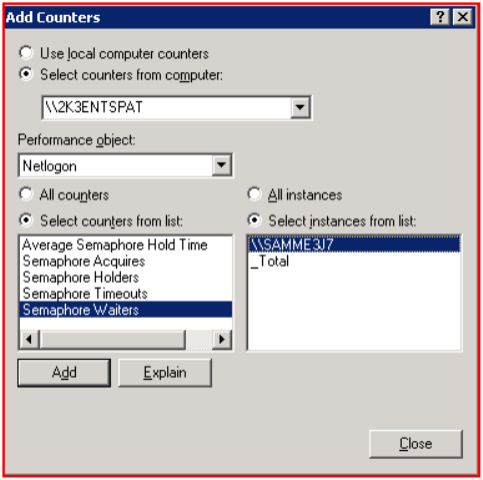MaxConcurrentAPI update - monitor the netlogon secure channel ... finally!
Edit 11/21/2011 NOTE: Please see https://support.microsoft.com/kb/975363 for updated informaton
Here is something which will be very very useful for a lot of larger IT shops.
It is a DCR which implements perfmon counters to monitor netlogon performance, specifically the scenario I discussed last year.MaxConcurrentAPI - or, how fast can you authenticate users?
Here was a comment on my previous blog entry:
# re: MaxConcurrentAPI - or, how fast can you authenticate users?
In the truted domains scenario, how is possible to verify the effect of this Key? Perfomon "NDTS\NTLM Authentications" item could be useful?
It could be nice to have a performance baseline before regkey optimization and after.
Well here we are…
The new code is available via a hotfix 928576 – don’t bother looking for a public KB yet – there isn’t one ( but should be out there soon )
In the meantime.. a little info about the fix.
Once you install it, ideally on all DC’s since you don’t know which one is going to be servicing secure channel traffic for a given client – then you need to register the perfmon counters via the following command:
C:\WINDOWS\system32>lodctr nlperf.ini
When you have done this you can then monitor the status of the semaphore which specifies the maximum number of simultaneous, logon-related, application programming interface (API) calls that can be transmitted across a secure channel at any one time.
Here is a simple screenshot – I have one domain trust here…
C:\WINDOWS\system32>nltest /sc_query:single
Flags: 30 HAS_IP HAS_TIMESERV
Trusted DC Name \\SAMME3J7
Trusted DC Connection Status Status = 0 0x0 NERR_Success
The command completed successfully
Average Semaphore Hold Time
Each time the semaphore is acquired we start a timer and when it is released we stop it. We take that value and divide it by the total number of times the semaphore has been acquired in order to provide you this average number of the hold time in seconds.
SemaphoreWaiters
This counter tracks the current number of threads that are currently waiting on the semaphore at any given point in time.
SemaphoreHolders
This counter tracks the current number of threads that are currently holding the semaphore at any given point in time.
SemaphoreAcquires
This counter tracks the total number of semaphore acquisitions that have occurred on the Secure Channel since the last time it connected. For the '_Total' instance this counters is from system boot. This counter gets incremented at the time the semaphore is released .
SemaphoreTimeouts
This counter tracks the total number of threads that have timed out while waiting to acquire the semaphore for this Secure Channel since the last time it connected. For the '_Total' instance this counters is from system boot.
Very very nifty to be able to track this instead of plowing through a bunch of netlogon logs.
Comments
Anonymous
September 25, 2011
Once again I am looking for info and I find myself reading one of your pages without realizing whose blog I am on. :) My issue is simple, I've pulled the counters via WMI and the hold times and system times are represented in a number that I don't recognize. Do you know how to convert these values into Julian clock?Anonymous
October 19, 2011
After cluttering your blog with my question I figured it out. These numbers are represented in nanoseconds.Anonymous
October 19, 2011
After cluttering your blog with my question I figured it out. These numbers are represented in nanoseconds.Anonymous
December 10, 2013
After cluttering your blog with my question I figured it out. These numbers are represented in nanoseconds.
